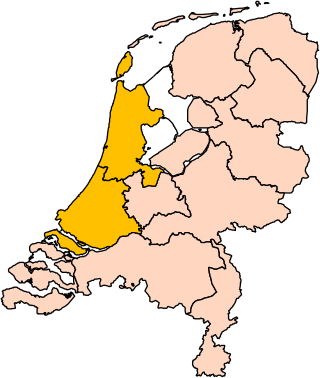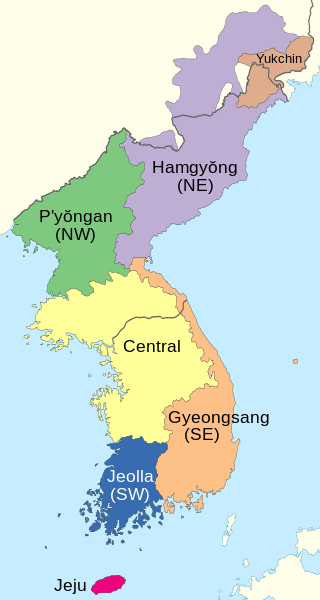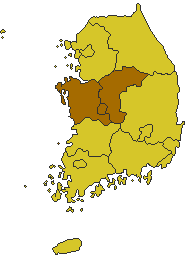
Holland is a geographical region and former province on the western coast of the Netherlands. From the 10th to the 16th century, Holland proper was a unified political region within the Holy Roman Empire as a county ruled by the counts of Holland. By the 17th century, the province of Holland had risen to become a maritime and economic power, dominating the other provinces of the newly independent Dutch Republic.

Korean is the native language for about 81 million people, mostly of Korean descent. It is the official and national language of both North Korea and South Korea. The language has notable differences in each of the Koreas, in part owing to different official standardizations of the language. They are still largely mutually intelligible, however. South Korean newspaper Daily NK has claimed North Korea criminalizes the use of the South's standard language with the death penalty, and South Korean education and media often portray the North's language as alien and uncomfortable.

Hanja, alternatively known as Hancha, are Chinese characters used in the writing of Korean. Hanja was used as early as the Gojoseon period under the first Korean kingdom.
Korea's provinces have been the primary administrative division of Korea since the mid Goryeo (Koryo) dynasty in the early 11th century, and were preceded by provincial-level divisions dating back to Unified Silla and Balhae during the Northern and Southern States period, in the 7th century.

Dalsland is a Swedish traditional province, or landskap, situated in Götaland in southern Sweden. Lying to the west of Lake Vänern, it is bordered by Värmland to the north, Västergötland to the southeast, Bohuslän to the west, and Norway to the northwest.

A circuit was a historical political division of China and is a historical and modern administrative unit in Japan. The primary level of administrative division of Korea under the Joseon and in modern North and South Korea employs the same Chinese character as the Chinese and Japanese divisions but, because of its relatively greater importance, is usually translated as province instead.

Gyeongsang was one of the Eight Provinces of Joseon Korea. Gyeongsang was located in southeastern Korea.

During most of the Joseon dynasty, Korea was divided into eight provinces. The eight provinces' boundaries remained unchanged for about 480 years from 1413 to 1895, and formed a geographic paradigm that is still reflected today in the Korean Peninsula's administrative divisions, dialects, and regional distinctions. The names of all eight provinces are still preserved today, in one form or another. These eight historical provinces form both North and South Korea, and are not to be confused with the provinces that make up South Korea or North Korea.

Wu is a major group of Sinitic languages spoken primarily in Shanghai, Zhejiang Province, and the part of Jiangsu Province south of the Yangtze River, which makes up the cultural region of Wu. Speakers of various Wu languages sometimes labelled their mother tongue as Shanghainese when introduced to foreigners. The Suzhou dialect was the prestige dialect of Wu as of the 19th century, but had been replaced in status by Shanghainese by the turn of the 20th century. The languages of Northern Wu are mutually intelligible with each other, while those of Southern Wu are not.
A regional language is a language spoken in a region of a sovereign state, whether it be a small area, a federated state or province or some wider area.

The administrative divisions of North Korea are organized into three hierarchical levels. These divisions were created in 2002. Many of the units have equivalents in the system of South Korea. At the highest level are nine provinces and four special municipalities. The second-level divisions are cities, counties, and districts. These are further subdivided into third-level entities: towns, dongs (neighborhoods), ris (villages), and workers' districts.

A number of Korean dialects are spoken on the Korean Peninsula. The peninsula is very mountainous and each dialect's "territory" corresponds closely to the natural boundaries between different geographical regions of Korea. Most of the dialects are named for one of the traditional Eight Provinces of Korea. Two are sufficiently distinct from the others to be considered separate languages, the Jeju and the Yukjin languages.
The Gyeonggi dialect or Seoul dialect of the Korean language is the prestige dialect of the language and the basis of the standardized form used in South Korea. It is spoken throughout the Korean Peninsula and in the Korean diaspora, but it is mainly concentrated in the Seoul National Capital Area, the most densely populated part of South Korea, which includes the cities of Seoul and Incheon, as well as the whole Gyeonggi Province. It is also spoken in the city of Kaesong in North Korea.

Hoseo is a region coinciding with the former Chungcheong Province in what is now South Korea. Today, the term refers to Daejeon, Sejong City, South Chungcheong and North Chungcheong Provinces. Hoseo people use Chungcheong dialect. The name is often used to refer to people residing in the region. Nowadays Chungcheong is more frequently used instead of Hoseo. The region will host the World University Summer Games in 2027.
Kwannam is a traditional Korean term used to refer to the southern region of Hamgyong province, including portions of modern-day North Hamgyong and South Hamgyong, North Korea. Its literal meaning is "South of the Ridge", the ridge in question being Mach'ŏnnyŏng 마천령 摩天嶺. The term is no longer in common use.
The Lao Nyaw, Thai Nyaw or Tai Yo are an ethnic group of Thailand, Cambodia and Laos, scattered throughout the provinces of Isan such as Nong Khai, Sakon Nakhon, Nakhon Phanom, and parts of Bolikhamxai and Khammouan provinces of Laos. They are also referred to as simply Nyaw or Yaw, depending on either the Lao, Isan, and Nyaw pronunciation, which all pronounce the initial consonant as, or the Thai pronunciation, which pronounces the initial consonant as.
The Hamgyŏng dialect, or Northeastern Korean, is a dialect of the Korean language used in most of North and South Hamgyŏng and Ryanggang Provinces of northeastern North Korea, all of which were originally united as Hamgyŏng Province. Since the nineteenth century, it has also been spoken by Korean diaspora communities in Northeast China and the former Soviet Union.

Lower Yangtze Mandarin is one of the most divergent and least mutually-intelligible of the Mandarin languages, as it neighbours the Wu, Hui, and Gan groups of Sinitic languages. It is also known as Jiang–Huai Mandarin, named after the Yangtze (Jiang) and Huai Rivers. Lower Yangtze is distinguished from most other Mandarin varieties by the retention of a final glottal stop in words that ended in a stop consonant in Middle Chinese.
Lan–Yin Mandarin (Lanyin) is a branch of Mandarin Chinese traditionally spoken throughout Gansu province and in the northern part of Ningxia. In recent decades it has expanded into northern Xinjiang. It forms part of Northwestern Mandarin. It has also been grouped together with Central Plains Mandarin. The name is a compound of the capitals of the two former provinces where it dominates, Lanzhou and Yinchuan, which are also two of its principal subdialects.

Mandarin was the common spoken language of administration of the Chinese empire during the Ming and Qing dynasties. It arose as a practical measure, due to the mutual unintelligibility of the varieties of Chinese spoken in different parts of China. Knowledge of this language was thus essential for an official career, but it was never formally defined. The language was a koiné based on Mandarin dialects. The southern variant spoken around Nanjing was prevalent in the late Ming and early Qing eras, but a form based on the Beijing dialect became dominant by the mid-19th century and developed into Standard Chinese in the 20th century. In some 19th-century works, it was called the court dialect.












